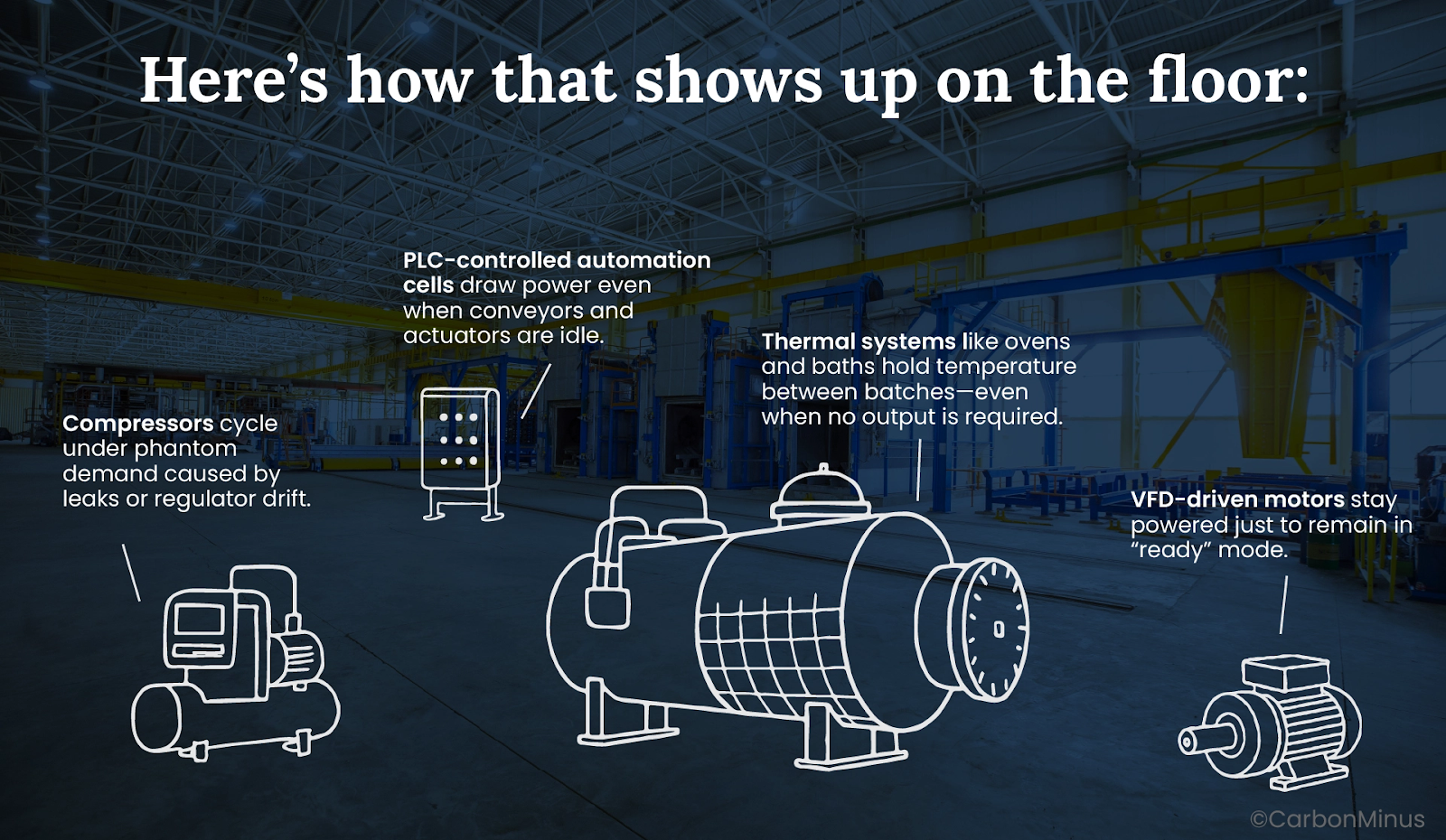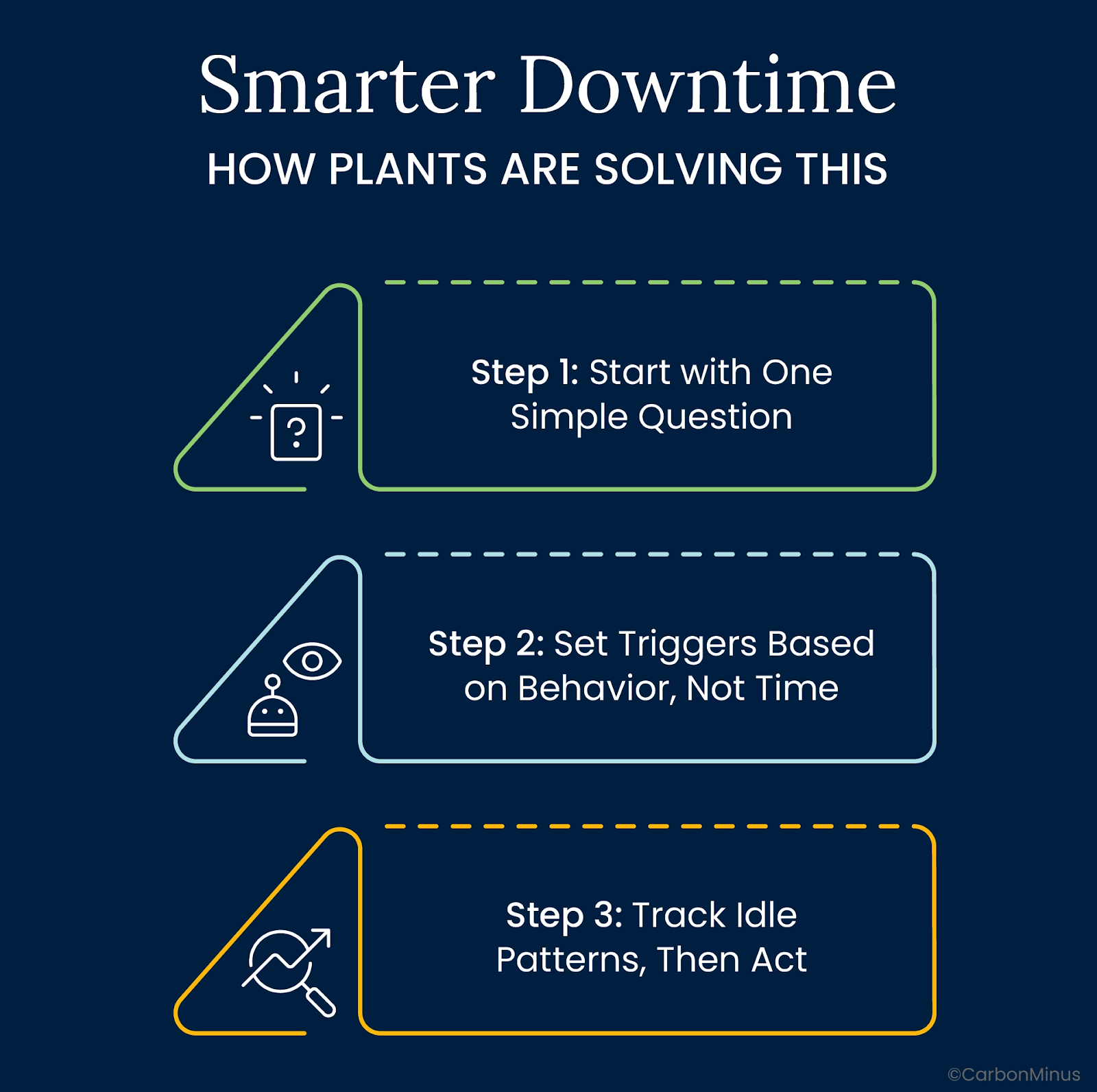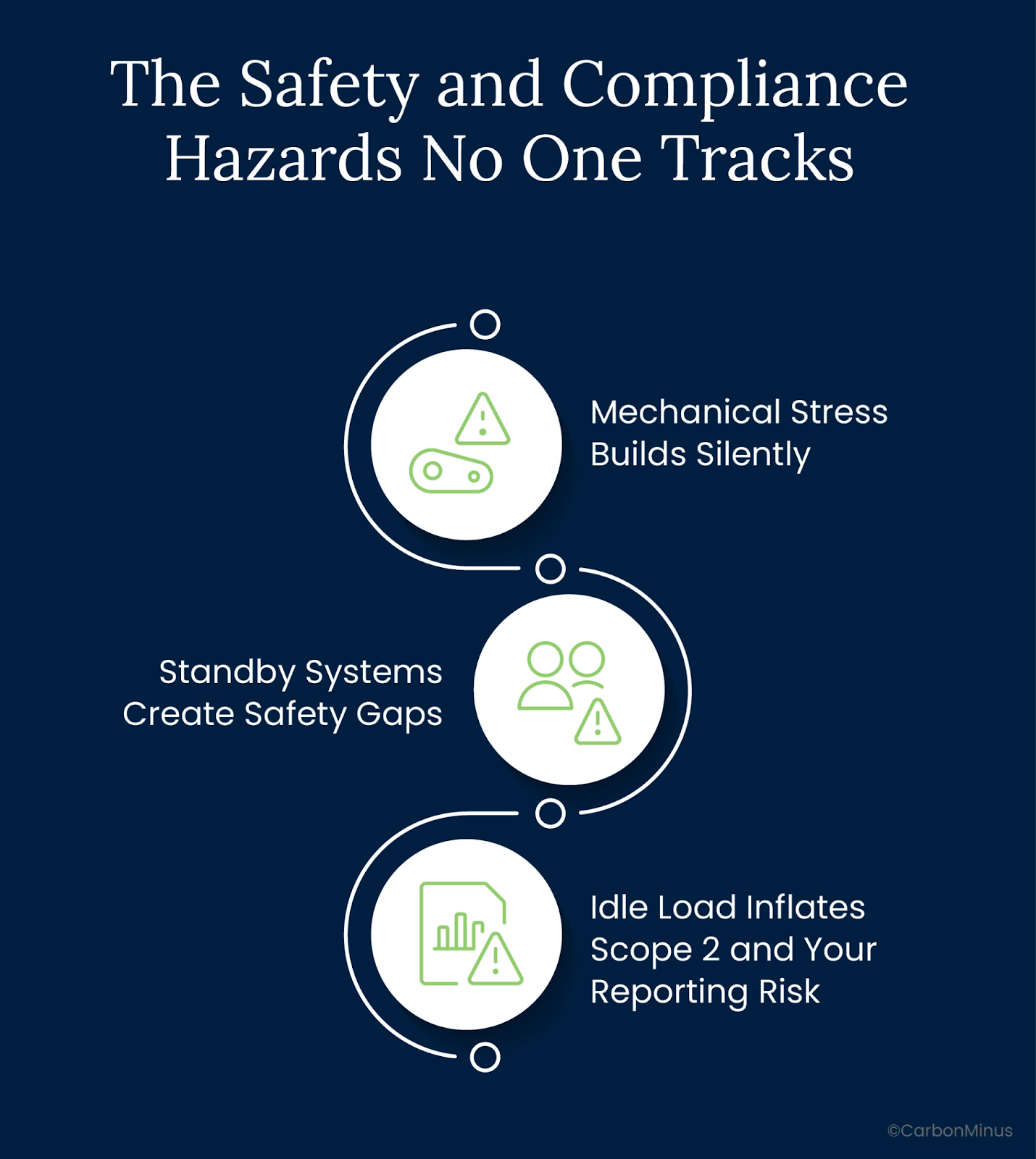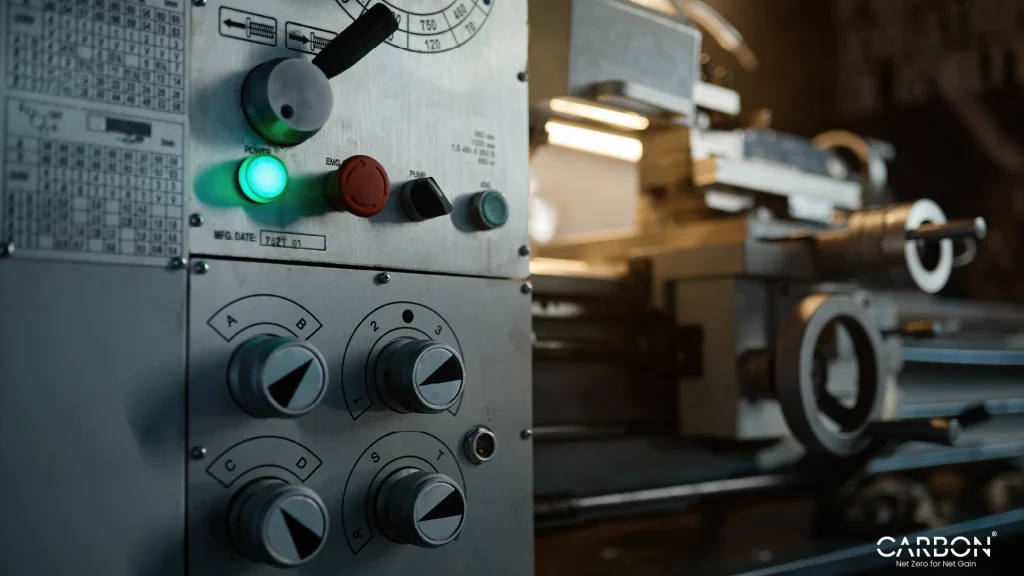Key Takeaways
- Idle machines can consume 15–25% of site energy—often unnoticed.
- “Off” in control logic doesn’t mean zero energy draw.
- Motors, compressors, and automation cells all carry standby load.
- Lack of asset-level metering keeps idle draw hidden.
- Plants over-prioritize readiness, causing unnecessary energy waste.
- Smarter SOPs and tiered logic can safely reduce idle time.
- Idle energy adds to Scope 2 emissions and compliance risk.
What costs thousands of kilowatt-hours, moves nothing, and never shows up on a maintenance log?
Your idle machines.
They don’t break. They don’t trigger alarms. But they burn energy—quietly and continuously—while doing absolutely nothing. And most of that waste goes unnoticed.
At one chemical plant, unnecessary chiller and pump operation during standby accounted for 63% of idle runtime. Fixing it saved over 117,000 kWh annually. In another case, a foundry eliminated 34% of its compressor idle time—cutting 163,320 kWh of waste with nothing more than real-time alerts and tracking.
This isn’t edge-case behavior. It’s common—and it’s expensive.
Idle load often hides in baseline usage, lumped together with fixed costs. No one owns it. No one’s measured against it. And in most plants, no one’s even looking for it.
Efficiency isn’t just about uptime. It’s about intentional downtime.
If your machines run by default—even when they’re not needed—you’re not operating lean. You’re operating blind.
Idle load is the quietest drain on your bottom line. And it’s one you can actually fix.
Idle Doesn’t Mean Off—It Means Unseen
Just because a machine isn’t producing doesn’t mean it isn’t consuming.
Most industrial control systems treat “off” as a state in logic—not in load. Equipment looks idle, but it’s still energized. Still drawing current. Still costing you.

| Equipment Type | Estimated Idle Draw (% Full Load) |
| VFD-Driven Motors | 10–30% |
| Compressors | 20–50% |
| Ovens & Heaters | 5–20% |
| PLC-Controlled Systems | 5–15% |
These systems aren’t broken. They’re behaving exactly as configured. But that configuration comes at a cost.
Field data shows idle equipment can draw anywhere from 5% to 50% of its rated load, depending on the asset and its control logic. And without asset-level visibility, that load gets averaged into your baseline—where it hides in plain sight.
Modern energy platforms solve this by tracking energy use at the asset level, in real time. When you can see what’s drawing power, when, and why—idle stops being invisible.
But if you’re only looking at total site consumption, you’ll never spot it
The energy isn’t lost because something failed. It’s lost because nothing was designed to stop it.
When you track energy use by machine state—not just uptime—you stop guessing. You start seeing.
When Readiness Costs More Than Runtime
If idle waste is so widespread, why do most plants let it slide?
Because the problem hides in the system—not the equipment.
1. No Asset-Level Monitoring
Most energy data stops at the panel. Without submeters or per-machine tracking, idle draw gets lumped into the baseline. It doesn’t look like waste—it looks like “normal.”
Energy platforms like CarbonMinus address this by layering real-time visibility on top of existing infrastructure—no rip-and-replace required.
2. Control Logic Prioritizes Safety, Not Efficiency
Drives stay live. Compressors stay pressurized. Heaters hold temperature. These defaults aren’t wrong—they’re safe. But they were designed for reliability, not optimization.
The result? Systems run “just in case,” even when the case never comes.
3. Energy Data Lives in Silos
Ops tracks output. Maintenance tracks uptime. Energy teams track bills. But idle draw sits in the middle—where no one owns it, and no one sees it.
Integrated dashboards and alerts break that isolation. When everyone sees the same signal, they can respond together.
4. Readiness Is Sacred
In high-pressure environments, no one wants to be the reason a line doesn’t start. So machines stay running—just in case. It’s not wasteful by intent. It’s defensive by design.
The hard truth? Most facilities don’t lack technology. They lack trust in the systems that make smart shutdowns possible.
That’s what real-time data fixes. It replaces fear with visibility.
Smarter Downtime: How Plants Are Solving This
Downtime isn’t the enemy. The problem is unplanned, unmanaged downtime—and machines left running just to play it safe.
The facilities getting this right aren’t guessing. They’re using real-time data to figure out exactly which machines need to stay on—and which ones don’t.

Here’s how that looks on the ground.
Step 1: Start with One Simple Question
What actually needs to stay powered between runs?
In most facilities, no one’s ever mapped that out. But once you do, it usually breaks down like this:
Some systems really are critical, like cleanroom HVAC or temperature-sensitive thermal loops. Shut them down too early, and you compromise product or safety.
Others are optional, like conveyors, mixers, even compressors that serve intermittent tools. These can often power down safely if the right checks are in place.
Once teams see this split clearly, automation becomes a support—not a risk.
Step 2: Set Triggers Based on Behavior, Not Time
The best plants don’t use timers. They use signals.
Auto-shutdown after 10 minutes of zero flow
Wake logic tied to batch scheduling or upstream activity
Alerts when idle draw exceeds defined thresholds
This is where energy platforms like CarbonMinus come in. By connecting load data, control logic, and production states, they enable automation that adapts to your actual workflow—not theoretical schedules.
Step 3: Track Idle Patterns, Then Act
Idle waste often hides in small anomalies. Load curves that creep up. Compressors that kick in with no trigger. Motors that stay “hot” overnight.
At one CarbonMinus-monitored foundry, analytics revealed unnecessary compressor cycling during shift transitions. Fixing the control logic cut idle time by 34%, saving 163,320 kWh annually.
Another chemical plant used CarbonMinus alerts to slash idle runtime on chillers and pumps by 63%, saving 117,032 kWh per year.
The lesson? Idle waste isn’t just fixable. It’s visible—once you start looking in the right place.
Turning SOPs Into Energy Tools
Idle waste doesn’t get fixed by technology alone. It gets fixed when teams treat it like any other process deviation—measurable, trackable, and worth improving.
That means folding it into the systems people already use: SOPs, reviews, and maintenance routines.
Make Idle Load Part of the Monthly Review
Most ops teams already track OEE, downtime, throughput. Add idle draw to that list. Look at standby energy by line. Set a baseline. Track drift. Once it’s visible, it becomes a variable teams can act on.
CarbonMinus helps teams do this by embedding energy performance into dashboards that plant staff already use—no separate system, no extra work.
Get Maintenance Involved Early
Many idle issues come from overrides, outdated logic, or small faults that never trip alarms. These aren’t breakdowns. They’re inefficiencies hiding in plain sight.
When maintenance has access to idle state trends, they can spot the drift before it turns into wear—or cost.
Use Machine State, Not Just Timers
Create simple logic trees based on behavior:
- If flow = 0 for 15 min → standby
- If torque < 5% for 10 min → shutdown queue
- Resume only with confirmed schedule or manual trigger
Logic like this is easy to deploy with systems like CarbonMinus, which tie production context directly into energy controls—no guesswork, no blind automation.
Avoid the Trap of Blind Efficiency
Just because you can shut something off doesn’t mean you should.
Every control strategy needs to match the process it’s built for. Otherwise, you’re just swapping one risk for another.
Use automation to support judgment, not replace it.
The Safety and Compliance Hazards No One Tracks
Idle machines don’t just drain energy. They introduce risk—mechanical, human, and regulatory.
And because most plants don’t monitor idle state conditions directly, those risks go unreported until something breaks, burns out, or gets flagged in an audit.

1. Mechanical Stress Builds Silently
Low-torque idle doesn’t preserve equipment. It strains it.
Motors running unloaded create uneven wear. Bearings heat without load balancing. Lubricants degrade without doing useful work. It’s slow damage—and it shortens asset life without setting off a single alarm.
2. Standby Systems Create Safety Gaps
A system in standby might look harmless. But if it’s live, it’s still dangerous.
A powered conveyor can move unexpectedly. A vessel holding heat or pressure remains hazardous even when not “active.” And without proper shutdown logic, standard LOTO procedures may not apply—putting inspection teams at risk.
3. Idle Load Inflates Scope 2 and Your Reporting Risk
Every kilowatt-hour burned in standby shows up in your Scope 2 emissions.
Under frameworks like CSRD in Europe and BRSR in India, unexplained baseline consumption becomes a disclosure risk. ESG reviewers are no longer just asking how much energy you use—they’re asking why.
CarbonMinus simplifies that accountability. Our Sustainability Module provides end-to-end emissions tracking across suppliers, logistics, and operations with automated data collection and audit-ready ESG reports.
This helps you align with ISO 14064 and GRI, while the Energy Review Module supports compliance with ISO 50001. Know more at www.carbonminus.com.
Idle waste isn’t just an efficiency issue anymore. It’s a compliance liability.
From Hidden Cost to Competitive Edge
Idle energy isn’t just waste, it’s opportunity cost.
Every unnoticed kilowatt is margin you didn’t protect. Every avoidable emission is scrutiny you didn’t escape. And every system left on “just in case” is another place your operation is paying for certainty it doesn’t need.
The best-performing facilities aren’t chasing perfection. They’re removing uncertainty—with visibility, logic, and clear accountability.
- They track idle draw like they track downtime.
- They make standby power a shared responsibility—not just a utility team problem.
- They turn SOPs, alerts, and dashboards into tools for action—not just reporting.
And they use platforms built for this job—systems that can connect live energy data, machine state, safety thresholds, and emissions reporting in one place.
Because in a future defined by net zero targets, regulatory pressure, and resource volatility, reducing idle load isn’t a nice-to-have.
It’s competitive hygiene.
In tomorrow’s factories, the quietest machines won’t be ignored. They’ll be optimized, or turned off.
FAQs
Why don’t audits usually spot idle energy waste?
Most audits are built around production efficiency. They track performance during active operation, not the gaps in between. If your equipment’s drawing power while offline, and your meters don’t measure per asset or per shift, that load blends into your baseline. It doesn’t look like a problem until you isolate it.
Isn’t it risky to automate equipment shutdowns between runs?
Yes, if you do it blindly. The goal isn’t automation for its own sake. It’s automation that reflects actual process needs. That means pairing logic with real-time signals: torque, flow, occupancy, scheduling. Risk comes from assumptions. Safety comes from visibility.
How do I make idle energy a shared responsibility, not just an energy team issue?
Start by reframing it. Idle draw is a process behavior, not just a utility metric. When you show line teams how much energy their equipment burns between batches—or how often “ready” equals “waste”—it stops being an abstract number. It becomes a performance lever they can control.
How does idle energy affect ESG reporting?
Idle energy adds to your Scope 2 emissions. It also signals that energy is being used without value—a red flag in any ESG review. Frameworks like CSRD and BRSR expect companies to show not just totals, but where the energy goes and why. If you’re not accounting for standby load, you’re exposing a blind spot in your disclosures.
How does idle energy affect equipment lifespan?
Running machines with no output still causes wear. Bearings rotate. Motors heat up. Sensors drift. Over time, that adds up to shorter service life and more unplanned maintenance. If you’re not tracking idle conditions, you’re not seeing the full impact on reliability—or the true cost of keeping things “ready.”
What’s the first step if I want to address this in my facility?
Don’t start with automation. Start with awareness. Pick one high-load line. Meter it. Break out standby power vs. productive power over a full shift. Once you have that picture, the inefficiencies sell themselves—and so does the case for smarter control.




